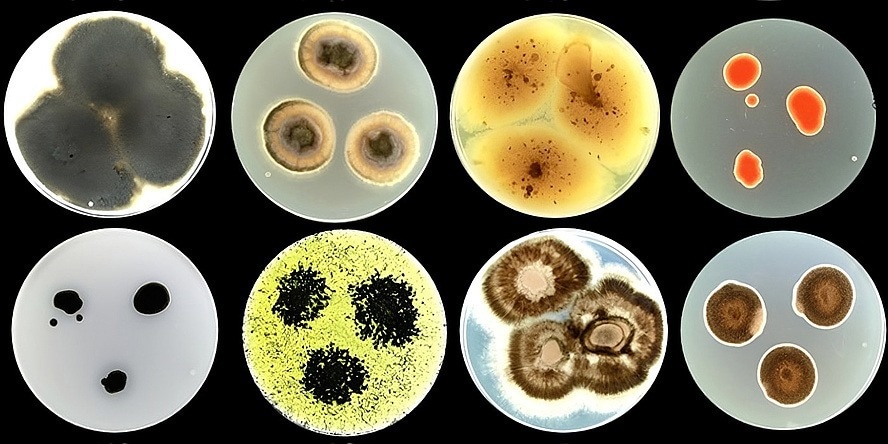Reviewed by Lexie CornerMay 23 2025
An international research team led by Graz University of Technology is developing façade coatings that incorporate specific microorganisms. These microbes are intended to bring building walls to life, provide surface protection, capture CO2, and filter air pollutants.
 A variety of fungal species isolated from building facades in the coastal city of Izola (Slovenia). Image source: Image Credit: Ana Gubenšek
A variety of fungal species isolated from building facades in the coastal city of Izola (Slovenia). Image source: Image Credit: Ana Gubenšek
Building façades are typically inert, offering no function beyond structural and aesthetic value. A multinational team of researchers and industry partners, led by Carole Planchette of the Institute of Fluid Mechanics and Heat Transfer, aims to change that by introducing microbial life to exterior walls.
As part of the project “Archibiome Tattoo for Resistant, Responsive, and Resilient Cities” (REMEDY), the team is developing a living ink that embeds beneficial microorganisms onto building surfaces made of concrete, wood, metal, and other common materials.
These microbial coatings - described as "living tattoos" - are designed to capture CO2, filter air pollutants, and protect façades from environmental degradation. The European Innovation Council is supporting the four-year project with nearly three million euros in funding through its Pathfinder program.
Billions of Square Metres of Potential Wall Space
In the next 25 years, the European Union plans to renovate or construct buildings with a combined 9.4 billion square meters of roofs and façades.
This is a huge potential that we should utilize. Microbiological communities on roofs and façades could fulfill numerous functions without taking up scarce, undeveloped space.
Carole Planchette, Institute of Fluid Mechanics and Heat Transfer, Graz University of Technology
Useful Microbiome for Buildings
A team led by microbiologist Nina Gunde-Cimerman at the University of Ljubljana is working to identify suitable microorganisms for this effort. Their goal is to establish stable, interkingdom microbial consortia for use on building surfaces.
Carole Planchette said, “The aim is to create a beneficial microbiome for buildings that is resistant to pathogenic microbes and repairs superficial cracks on its own. Additional benefits will range from carbon sequestration and oxygen production to bioremediation, among others.”
Planchette, from the Institute of Fluid Mechanics and Heat Transfer, is responsible for developing a printable ink that supports microbial viability.
“We opted for inkjet printing because it allows us to apply the living ink very precisely, in a controlled manner and quickly at the same time,” explained Carole Planchette.
One challenge is the size of the microorganisms, which can reach several micrometers and are expected to cluster in millimeter-sized groups. Traditional inkjet systems, designed for nanoscale particles, are not equipped to handle such large biological material.
To overcome this, Planchette is collaborating with Austrian coating company Tiger Coatings and Slovak inkjet manufacturer Qres Technologies to develop the necessary technological adaptations.
Technology Breakthrough
The ambition of REMEDY is to achieve a breakthrough in fundamental research in microbiology and synthetic biology, transfer the know-how to materials science in the form of engineered living materials, and develop compatible biofabrication processes that allow personalized design in the architectural context.
Anna Sandak, Project Coordinator, InnoRenew CoE in Izola
“I am confident that we will develop suitable inks and the customized inkjet technology within the project duration,” said Carole Planchette.
I also expect that we will find suitable microorganisms that survive in the ink and under the stress generated by printing. It will be interesting to see whether we succeed in making this process fully reproducible over the next four years. Using living, thus evolving, inks for industrial processes such as inkjet printing, which tolerate little parameter variations, is a challenge, as we are entering uncharted territory with the REMEDY project.
Carole Planchette, Institute of Fluid Mechanics and Heat Transfer, Graz University of Technology
Slovenia, Austria, the Netherlands, and Slovakia are the four EU countries represented among the consortium's six partners.
The partnership is coordinated by InnoRenew CoE and includes the University of Ljubljana, Graz University of Technology, TIGER Coatings, Xylotrade B.V., and Qres Technologies. The University of Primorska is contributing in-kind support as a third party.